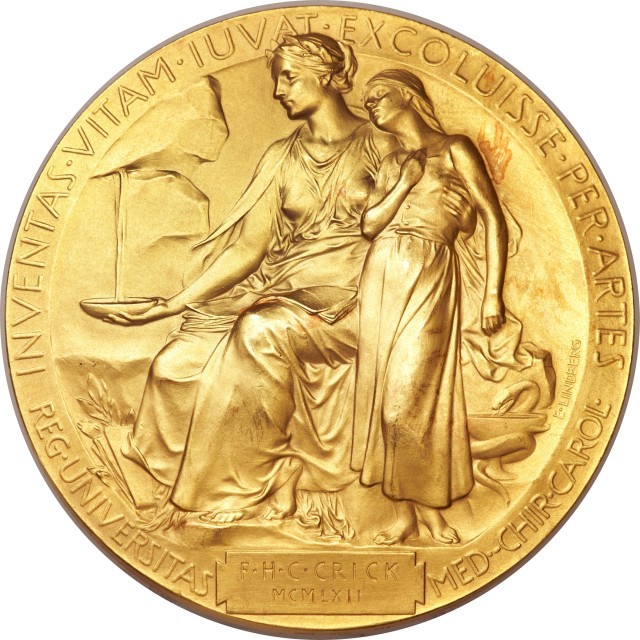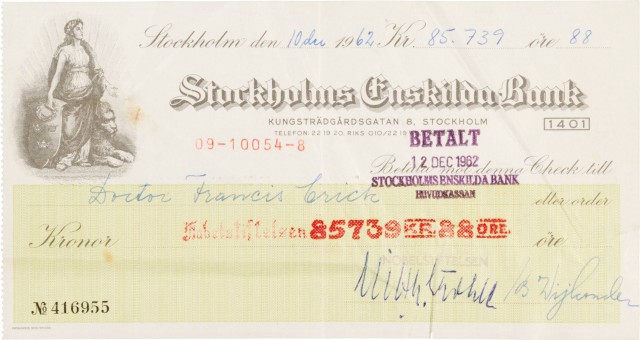The Great Nobel Prize Cash-In Begins With A Big Bang

What is the current market value of a Nobel Prize? Until yesterday, that question would have been virtually impossible to answer, which proved to be advantageous to the family of Francis Crick. Heritage Auctions, the entity that conducted the sale of Crick’s 23-carat gold medal in New York this week, declared it a “historic moment.”
As such, bidding started at $250,000.
1 Niels Bohr offered his own Nobel Prize to benefit the Finland Relief in 1940. It was purchased by an anonymous bidder who donated it to the Frederiksborg Museum. Son Aage Niels Bohr, a nuclear physicist, also won the prize. The younger Bohr died in 2009, and whoever inherited his medal sold it at auction just last November, for €37,500. The bidder wished to stay anonymous, and the fate of the medal is unknown.
In a wonderfully dramatic — but woefully inaccurate — statement on their website, Heritage declared that it was “the first time in 70 years that a Nobel Prize has been sold at public auction.”1 A handful of medals have indeed been sold, but almost all by, and in order to fund, charitable institutions.
Crick heirs, however, are splitting the lion’s share of the $2.27-million final bid amongst themselves. The family has promised 20 percent to the Crick Institute in London, a medical research institute slated to open in 2015.
Francis’ descendants placed the majority of the Nobel laureate’s legacy on sale this week. Their timing was impeccable, but far from serendipitous. According to granddaughter Kindra Crick, the family planned the auction to coincide with the 60th anniversary of Francis’ discovery of the double helix of deoxyribonucleic acid. In layman’s terms, he co-discovered the structure of DNA, considered the most significant advancement in the biological sciences since Darwin’s theory of evolution.2
The Crick family’s offerings were breathlessly reported by nearly every major news outlet, from the Wall Street Journal to MSNBC, but journalists seemed curiously unwilling to cast a critical eye. Hardly a sound was made about the allocation of profits, the timing — or the original intent of the Laureate himself.
2 It will be hard to conclude that the gravity of the discovery fully accounts for the high price, as James Watson’s medal, who shared the prize with Crick, is likely to garner a lesser bid. Watson was a celebrated scientist until, in 2007, he told the British Sunday Times Magazine that Africans were less intelligent than Europeans. Sure, he too wanted to believe in equality, but “people who have to deal with black employees find this not to be true.” He did apologize after facing suspension from his lab in Cold Springs, but he’s made similarly offensive statements before, alleging that heavier individuals are less likely to get hired because they lack ambition, and that sunlight surely accounts for the “Latin lover’s” libido. His comments on the person and appearance of Rosalind Franklin, the biophysicist who made critical contributions to the understanding of fine molecular structures of DNA, RNA, viruses, coal, and graphite, deserves an article of its own.
Over and over again, iterations of the following AP line appeared, often in its own paragraph: “The items are among a dozen artifacts Crick’s heirs are selling to benefit scientific research.” Yes, 20 percent of the profits will go to science, but isn’t that really just a tip, if, at least, a decent one? It seems clear that the heirs sold Francis’ medal and personal items to benefit the Crick family.
On Wednesday, son Michael Crick sat in the audience at Christie’s Auction House and watched a 1953 personal letter his father penned go to an anonymous bidder for $6,059,750. He received the seven page letter, which opened with “Dear Michael, Jim Watson and I have probably made a most important discovery,” and concluded with “Lots of love, Daddy,” when he was away at boarding school. It included rough sketches of the base pairs connecting the molecule’s twisted spines, but Michael, now age 72, had kept the letter tucked away in a plain envelope for decades. A year after his father died, however, “somebody thought it might be valuable.” Christie’s agreed, comparing it to a 1939 letter Albert Einstein addressed to Franklin D. Roosevelt.3

3 Crick’s letter fetched a higher price than one written by Abraham Lincoln, which sold for $3.4 million in 2008.
Kindra stressed that the letter belonged to her father, not her family. For his part, Michael has told various media outlets he will donate half of the total profits to the Salk Institute for Biological Studies in La Jolla, California, where Francis had been a professor. It’s unclear who will profit from other items sold by Christie’s yesterday, including $17,000 for a notebook, and $14,000 for the iconic drawing made by Odile Crick, Francis’ widow, of the double helix.
At Heritage, Shanghai-based executive Jack Wang scooped up, in addition to the Nobel Prize itself, most of the family’s other offerings. He scored the medal’s accompanying diploma, and paid $77,675 for Francis’ canceled check from the Nobel Prize Committee in 1962, which boasts a face value of 85,739.88 Swedish krona. Wang completed his buying spree with Francis’ lab coat, emblazoned with the gold spiral logo, for $8,962.50. According to Greg Rohan, president of Heritage Auctions, the items will likely be displayed together in Shanghai in order to promote science and medicine, but there are no guarantees.
If Wang decides to keep the items locked away, never again to be seen by the public, he would be well within his rights. Unless the anonymous bidder from Christie’s donates Francis’ letter to a museum or collecting library, its secluded fate is sealed.
“We were advised not to attach any strings,” Kindra said over the phone before the auction, despite telling most news outlets that the family was motivated by a desire to make the items available to the public. During Francis’ life, he kept the prize locked away in a room with other important documents. After his widow died in 2007, the family placed it in a bank vault for safekeeping.
To echo the sentiments of Soraya de Chadarevian, a science historian at the University of California, Los Angeles, “it would have been better placed in an archive.” Many donors meet with potential institutions in order to negotiate terms. It’s not uncommon to specify that items must be seen by the public on a yearly basis.
4 He also appeared to be a man of principle. Part of the reason he accepted an honorary fellowship at Churchill College, Cambridge, was that, in 1960, the new college did not have a chapel. When a large donation was accepted to establish one, Francis resigned in protest. Also to be filed under things we know about Francis: He believed in the theory of panspermia, asserting that life was seeded on Earth by a kind of intergalactic “sperm” that arrived via comet or meteor. Many have discounted this theory using Francis’ own research on DNA. The molecule would likely decay during the time it takes to travel from one star to another.
How would Francis have felt about all of this? Kindra explained his only specifications had to do with his scientific papers, which he donated to the U.S. National Library of Medicine. Copies are also available at the University of California, Santa Barbara, but most are digitized and available online. In other words, Francis seemed to believe in free and open access, as well as the effectiveness of archives that ensures this.4
While Francis Crick once again made history this week, his heirs seemingly initiated a trend. The Copenhagen auction house Bruun Rasmussen has announced that they will be selling scientists Ben Mottelson’s 1975 Nobel Prize and Sune Bergstrom’s own 1982 medal next month. In June, Sotheby’s will be auctioning off William Faulkner’s Nobel Prize medal, along with unpublished stories and personal letters. Lee Caplin, executer of the estate, told the New York Times that Faulkner’s heirs hoped it would end up at a public institution, but, like the Crick family treasures, it looks like the goods will go to the highest bidder.
Alexis Coe is now a writer living in San Francisco, but not long ago, she was a research curator at the New York Public Library. Her work has appeared in the Atlantic, Slate, The Millions, and other publications. Alexis holds an MA in history. Follow her.
